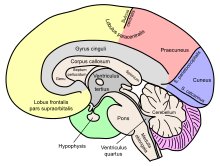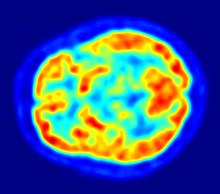User:Gilyardterence/Pediatric Acquired Brain Injury
Summary:[edit]
"Pediatric Acquired Brain Injury (PABI) is the number one cause of death and disability for children and young adults in the United States."[1] Pediatric Acquired Brain Injury (PACB) effects most children ages (6-10) and adolescent ages (11-17) around the world. The injury can be caused from different types of falls, and most patients never return back to normal after suffering from the injury.

There are many different symptoms such as amnesia, anhedonia, and apraxia. Currently there isn't a cure for the injury, but different programs such as the The Pediatric Acquired Brain Injury Community Outreach Program (PABICOP) work on helping children cope with their Pediatric Brain Injury. (PACB) effects the family of the patient also, because the families of the patient will need to adapt to the new changes they will experience in their child. It is recommended that the families decide to gain as much information as they can about the injury and what to expect by going to different program events and meetings.

Pediatric Acquired Brain Injury[edit]
The term "pediatric" in this case encompasses brain injuries sustained from birth up to age 25, since the developing brain does not finish maturing until that time. An acquired brain injury (ABI) can be sustained from traumatic brain injury such as falls, motor vehicle incidents, sports concussions, blast injuries from war, assaults/child abuse, gunshot wounds, etc.) and non-traumatic brain injury (i.e. stroke, brain tumors, infection, poisoning, hypoxia, ischemia, encephalopathy or substance abuse).[2]
Behavior of those suffering from Pediatric Brain Injury[edit]
In children and adolescent that have an acquired brain injury, the cognitive and emotional difficulties that come about from their injury can negatively impact their level of participation in home, school and other social situations.[2] This puts the patient at a disadvantage because they won't nearly as social, or able to participate in a school setting as an ordinary child would. Involvement in social situations is important for the normal development of children as a means of gaining an understanding of how to effectively work together with others.[2] Group work is a huge factor is academics today, and the child's ability to work within groups will be ineffective. Furthermore, young people with an acquired brain injury are often reported as having insufficient problem solving skills. This has the potential to hinder their performance in various academic and social settings further.[2] It is important for rehabilitation programs to deal with these challenges specific to children who have not fully developed at the time of their injury.
Symptoms[edit]
Some symptoms that result from an acquired brain injury are amnesia, anhedonia, and apraxia.
Amnesia[edit]
"Childhood amnesia is the inability to remember one's own childhood." Researchers found that some everyday activities such as speaking, running, or playing a guitar, cannot be described or remembered.
Anhedonia[edit]
A child that is diagnosed with anhedonia would lack interest in some usual activities, such as hobbies, playing sports, or engaging with friends. It's very essential for a child to be able to enjoy fun childhood activities because it can help them build a social life, and easily interact with others. Not being able to do these things at a young age will only make it harder to adapt as the child gets older.
Apraxia[edit]
"Apraxia is the inability to execute learned purposeful movements, despite having the desire and the physical capacity to perform the movements." In this case, the child could have still have the memory of doing a usual activity such as riding a bike, but still not be able to accomplish the movement.
Training[edit]
There are many different ways to "train" the children diagnosed with Pediatric Brain Injury. The training mainly tests their brain, to see exactly what's wrong with the patient, and what areas need to be focused on for improvement.
AIM program[edit]
"AIM is a 10-week, computerized treatment program that incorporates goal setting, the use of metacognitive strategies, and computer-based exercises designed to improve various aspects of attention."[3] "During the initial meeting with the child, the computer program leads the clinician through an intake procedure that assists in identifying the nature and severity of the child's attention difficulties and then facilitates the selection of attention training tasks and metacognitive strategies tailored to the needs of the child." The clinician's role is to select the specific, presenting mental areas that are impaired, as well as to modify the tasks and strategies in response to improvements of the patients' overtime. [3] This is a helpful way to figure out what problems the child/adolescent is facing, while also helping them to gradually improve their injury.
Parent's Assistance for Patients[edit]
"Investigators have established that interventions for pediatric BI should target the family because changes in one family member will affect the entire family system."[4] "During rehabilitation, caregivers often receive skills training to improve their ability to care for their child after their brain injury.[4] Family realignment and adjusting the child's environment are two major ways parents can make the distresses of the injury easier on their child. Some beneficial ways parents can realign their household are applying consequences to minimize problem behaviors, increasing the amount of positive communication between parents and child with injury, and establishing positive routines that will instill meaning into the child's day-to-day life.[4]
The Pediatric Acquired Brain Injury Community Outreach Program (PABICOP)[edit]
The team includes several members: a pediatric neurologist, a community outreach coordinator, school liaison personnel, an occupational therapist, and a speech language pathologist.[5]
"The philosophy of the comprehensive acquired brain injury program for children/youth is that it be holistic, and parent and family centered, and that it incorporate and involve the community at large in the ongoing care and management of the child/youth with acquired brain injury while supporting the family. It also includes the ideas of continuity, accessibility, knowledge, collaboration, empowerment, and advocacy"[5]
The program also provides families with information about PABI, and what they should expect over the following couple of months. The PABICOP provides the families with packages of how to cope with the different symptoms the child may display, and some useful suggestions. Unfortunately, sometimes program leaders give parents the heart-breaking news that their child may never return to how they were before in some aspects. "The Pediatric Acquired Brain Injury Community Outreach Program (PABICOP) – An innovative comprehensive model of care for children and youth with an acquired brain injury"[5]
References
- ^ "Pediatric Acquired Brain Injury".
- ^ a b c d "Acquired Brain Injury". Retrieved 5 November 2014.
- ^ a b Sohlberg, Mckay; MacPherson, Holly; Wade, Shari (2014). "A Pilot Study Evaluating Attention And Strategy Training Following Pediatric Traumatic Brain Injury": 2, 5, 6, 7.
{{cite journal}}:|access-date=requires|url=(help); Cite journal requires|journal=(help) - ^ a b c Cole, Wesley; Paulos, Stephanie (2009). "A Review of Family Intervention Guidelines for Pediatric Acquired Brain Injuries": 2, 5, 6.
{{cite journal}}:|access-date=requires|url=(help); Cite journal requires|journal=(help) - ^ a b c Gillett, Jane (2004). "The Pediatric Acquired Brain Injury Community Outreach Program (PABICOP)": 3, 4.
{{cite journal}}:|access-date=requires|url=(help); Cite journal requires|journal=(help)
